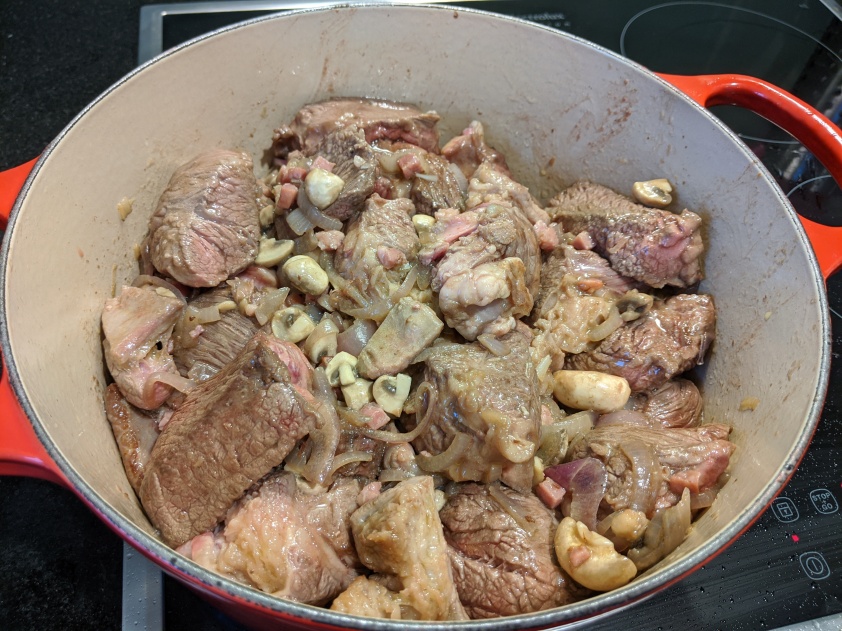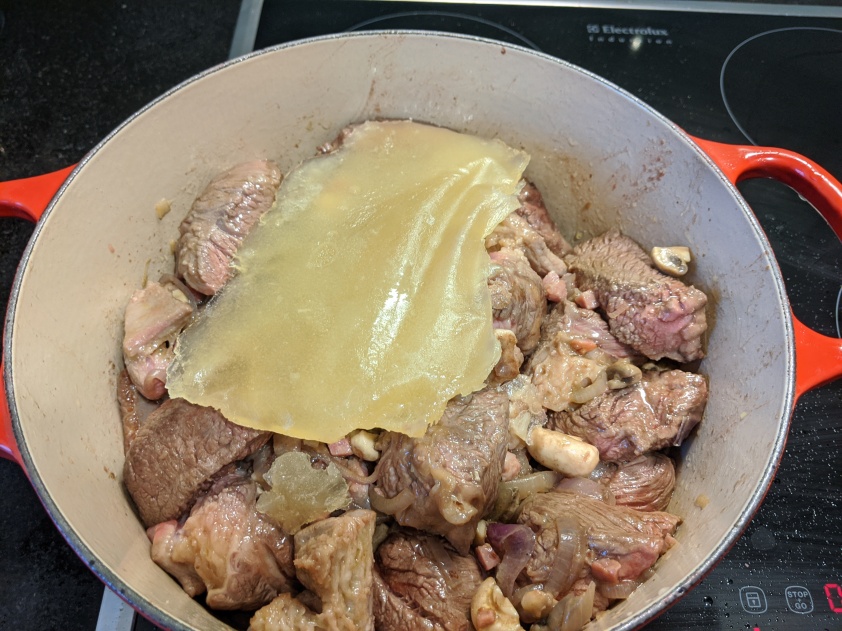Okay, I have an urge to write, and to put content out there that’s not strictly related to the current situation, so let’s do that. This is not going to be a fancy blog post with amazing pictures (I shot these with my phone and under crap lights) and a precise recipe, just some stream-of-consciousness narrative on how to get a hard-to-mess-up-completely beef stew. If you want the high-effort, but actually worth it, version, there’s one here: Bœuf bourguignon.

Get some stew beef – typically the cheap cuts, that may be more or less tough and have more or less fat/weird parts. For this round I got one piece of « meager stew beef » (which would be tougher without the long cooking) and one piece of « mixed stew beef » – which is typically fattier and has more squishy parts. Cut it in large cubes (okay, some kind of approximately 6-faced polyhedrons) – I like something along the lines of 3-5cm side, I think. Try to keep them roughly equal, but don’t fret.
Get your largest pot – mine happens to be my cast iron dutch oven, and there’s something very satisfying in cooking anything in that, but any pot ends up working – this dutch oven is a fairly recent addition to my cookware, but I’ve been making stew for as long as I’ve had my own kitchen. Put some fat at the bottom – oil, butter, lard, whatever floats your boat, and brown all the pieces of meat. You probably want to do several batches, in order to not crowd the pot – I had roughly 2kg of meat and it took me 4 batches. You might want to dust the meat with flour – it tends to brown better, and it eventually helps with the thickness of the sauce, but it also tends to stick more to the bottom of the pan, which makes it a bit more stressful. I couldn’t decide between putting flour or not putting flour, so I put just a little, which meant that my meat was stickier to the bottom of the pan and the sauce didn’t really thicken. Win-win.

Once all the meat is browned, you may want to add a bit more fat to the pan if it’s all out, and then throw in a few onions. Add some bacon too, because bacon makes everything better.

Throw in some mushrooms while you’re at it. You could also add a carrot or two there – always a popular choice.

Let everything in there soften and brown for a bit. Then add back the beef.

Stir everything together, and that’s when you can add liquid. I started with a cup of chicken broth that was in my freezer (I made broth two months ago, and I’m very happy I did). Don’t worry if you don’t have any – it’s probably helping for the overall taste, but it’s not critical. You can also add (on top of or instead of) herbs, typically a bouquet garni, or whatever aromatics you think would work (thyme, laurel, rosemary, garlic – all of these would probably work).
Once you have a bit of liquid in the pot, scratch the bottom of the pot with a spatula – should help liberate all the tasty bits that gathered in there while browning everything (and have them in the final sauce).

Open a bottle of red wine and check that it is appropriate. Rule of thumb: don’t cook with something you wouldn’t drink. First of all, it’s going to be less tasty; second of all, if you have some left, you’re going to drink it anyway with the meal, soooo.

The second point was not much of an issue for me, because I ended up needing the whole bottle in there. Cover the content of the pot with liquid – if you don’t have enough red wine, add some more broth or water. Bring to a boil.

Once it’s boiling, reduce the heat below, add a lid to the pot, and let it simmer for a couple of hours (or more). Double check at the beginning of the cooking that it’s not boiling too heavily (since there’s a lid on, this typically happens at lower heat on the stove!), and let it be for a while.

A few hours later, you have a very tasty dinner, and probably a fair amount of leftovers (unless you’re cooking for 10+ people). If you’d like a thicker sauce (the one I had was fairly thin, you can strain everything out of it and reduce it on high heat for a while. I was definitely too lazy (and it was getting late) to do that yesterday.
Once cooled down, transfer to freeze-ready containers, add a label on it, and stick them in the freezer for a later day.
Don’t be me when doing that: I tried to spare time by tipping the pot over my containers to get some sauce in it, and I ended up having to clean a sauce flooding in my kitchen, that was annoying.
More annoying even is that on that evening I ended up having to clean a SECOND flood in my kitchen. When I went to put my stew boxes in the freezer, I realized that one of my chicken broth bags had leaked – it was probably not sealed correctly  Hence, more mess to clean. So I picked the drawer, emptied it and put it in the sink to clean it. At some point I went « WAIT, WHAT, WHERE IS ALL THAT WATER COMING FROM?? » – turns out, my freezer drawer are not watertight (the facade is clipped on them). Which means: second kitchen flooding in one evening.
Hence, more mess to clean. So I picked the drawer, emptied it and put it in the sink to clean it. At some point I went « WAIT, WHAT, WHERE IS ALL THAT WATER COMING FROM?? » – turns out, my freezer drawer are not watertight (the facade is clipped on them). Which means: second kitchen flooding in one evening.
But at least I have tasty stew for comfort 


















